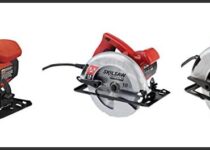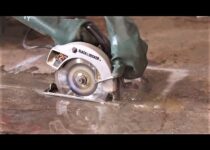Why Does My Circular Saw Not Cut Straight – Doubts You Should Clarify About
If you’ve recently purchased a circular saw and tried to use it, only to find out that your cuts are far from straight, then you may be wondering why. This is an unfortunately common problem for new users of this power tool. Many factors can lead to crooked or jagged edges on the material being cut with a circular saw, such as incorrect blade depth setting or incorrect alignment of the fence.
In addition, inaccurate cutting techniques or low-quality blades can also lead to inefficient results when using a circular saw. To get clean and straight cuts every time – no matter what type of material you’re working with – there are certain steps that must be taken in order to ensure accuracy and precision while operating this powerful machine.
If you’re trying to make a perfect cut with your circular saw and it just isn’t happening, you may be wondering why. The truth is that there are several potential reasons why your circular saw isn’t cutting straight. In this blog post, we’ll explore some of the most common causes for an uneven cut so that you can troubleshoot and get back to making those precise cuts.
The first thing to check when trying to determine why your circular saw isn’t cutting straight is the blade itself. A dull or damaged blade will cause jagged edges when making a cut, which can look like an uneven line. Make sure the blade is sharpened or replaced as needed before attempting any further diagnostics.
Another potential issue could be that the base plate on your circular saw has become misaligned over time due to wear and tear from use. If this is the case, then it’s likely causing inaccurate cuts because it’s not allowing for proper stabilization while in operation. To correct this problem, loosen all screws on the base plate and adjust until perfectly aligned again before re-tightening them securely into place.
Finally, if none of these solutions seem to help solve your problem then you may need to recalibrate your circular saw by adjusting its depth setting and fence alignment accordingly. This process involves fine-tuning various parts of the saw so that they accurately reflect each other in order to ensure even cuts every time—a key factor in achieving crisp lines with no deviations whatsoever! It’s important to always refer back to manufacturer instructions when performing any adjustments like these though; otherwise, improper calibration could lead to more problems down the line.
In summary, there are numerous possible explanations as to why your circular saw might not be cutting straight – from dull blades all way through misalignment issues at either end of its baseplate or incorrect calibration settings within its interior components – but thankfully each one has a relatively straightforward solution attached too! Take some time out today just diagnose what exactly is going wrong with yours so that you can quickly get back up and running optimally once more!
Dewalt Circular Saw won’t Cut Straight
If you own a Dewalt circular saw, then chances are that at some point in time you have experienced it not cutting straight. This is a common problem and can be fixed with relative ease. Knowing what the issue is and how to fix it will help you get your Dewalt saw back up and running properly.
The most common reason why a Dewalt circular saw won’t cut straight is due to an inaccurate or worn-out blade guard adjustment screw. The screw allows the user to adjust the depth of cut for various types of materials but if this adjustment becomes inaccurate, it could cause your cuts to be misaligned or angled incorrectly. To ensure proper alignment when using your circular saw, make sure the blade guard adjustment screw is securely tightened into place before use each time.
Additionally, check periodically throughout use as any looseness could cause further issues down the line. Another potential culprit behind why your cuts may not be coming out accurately could stem from a dull or damaged blade itself. If either of these conditions exists on your current blade then replacing it should rectify any misalignment issues you are experiencing in no time flat!
Be sure to select one with appropriate teeth per inch (TPI) for whatever material type you are working with as different types require different TPI blades for optimal results when cutting through them all together. Finally, another possible explanation for poor accuracy comes from an old power cord connection which has become loose over time leading to inconsistent power delivery while operating your tool causing varying degrees of performance accordingly including problems such as inaccuracy while making cuts intermittently during operation – To address this problem simply inspect both ends of the cord connecting into/out-of machine looking for any signs of wear & tear before replacing if necessary otherwise tightening firmly by hand should do trick getting everything back up & running optimally once more! In conclusion, there are multiple reasons why a Dewalt circular saw might not cut straight ranging from simple fixes like checking/tightening screws/connections, etc.
To more involved replacements like new blades and even cords depending on severity found upon inspection – As long as regular maintenance routines such as those mentioned above are observed regularly then operations should remain consistent without the need to worry about further accuracy issues arising anytime soon thereafter!

How Do You Make a Circular Saw Cut Straight?
If you’re working with wood, a circular saw is an invaluable tool. But if you don’t know how to use it properly, your cuts won’t be straight and the results will suffer. So in this blog post, we will cover how to make a circular saw cut straight every time.
First, start by making sure that your circular saw is set up correctly; if the blade isn’t at 90 degrees relative to the base of the unit then your cuts won’t come out right. You can adjust this using the tilt-adjustment knob on most models (if yours doesn’t have one then check for any other adjustments). Once you’ve got that set up correctly, it’s time to move on to actually cutting something!
The next step involves marking where you want your cut line to go – do this by drawing a pencil line across whatever material you’re working with and ensuring it’s as straight as possible (this will help make sure that when you start cutting, there are no discrepancies between what should happen and what does happen). This line should also be wider than your actual cut so that when everything is done there are still some visible markings left on either side of the finished edge – these act like guidelines for keeping things nice and neat while operating.
Once all of this has been completed successfully its now time to get ready for cutting: put on safety glasses or goggles before starting any kind of work with power tools like a circular saw; place whatever material needs cutting onto a solid surface such as a bench top or flat ground area; ensure that both hands are free from potentially hazardous areas whilst making contact with moving parts during operation; securely clamp down anything being worked on so it doesn’t move around while being cut into shape – use clamps or weights depending upon size/ weight etc.
Finally, switch on & carefully lower the blade until it just touches but does not penetrate through your marked guidance lines – double-check everything is secure again before continuing further! Now comes the important part: keep control over where and how quickly/slowly you move forward along previously marked guidance lines – slow & steady wins here; press firmly against materials being worked upon while tracking towards desired endpoints without deviating away from pre-marked boundaries.
Once finished let off the pressure applied via handle grips and switch off the machine completely before removing items from clamped positions (or vice versa) – Congratulations! You now know how to make clean accurate cuts using only basic knowledge about setting up & safely operating Circular Saws!
Why Does My Saw Not Cut Straight?
If you’re trying to make a straight cut with your saw and it’s not coming out right, there could be a few different reasons why. This problem can range from something minor that is easily fixed to more serious issues that may require professional help. The first thing you should do when troubleshooting this issue is to check the blade of your saw for any damage or dullness.
A worn-out or damaged blade can cause the saw to produce crooked cuts as it won’t be able to cut through material evenly. If the blade appears fine, then it might be time to take a look at how you’re using the saw itself. Make sure that you are holding and guiding the saw correctly so that it doesn’t drift off-course while cutting, as well as ensuring that all of its settings are correct (e.g., speed).
Another possible reason why your saw isn’t producing straight cuts is because of a misalignment between its motor and its guide rail/track system—i.e., if they aren’t completely parallel with each other, then this will create an uneven force on the blade which in turn causes irregular cutting patterns. To fix this issue, make sure both components are properly aligned before attempting another cut with your saw. Finally, if none of these solutions have worked for you thus far, then there could potentially be some sort of internal mechanical failure occurring within your tool—such as faulty bearings or misaligned gears —that needs further inspection by an experienced technician in order to diagnose and remedy properly.
In addition, always double-check whether all of the screws/bolts on moving parts like rails/tracks are securely fastened prior to use; loose hardware can sometimes lead to problems such as incorrect alignment too! Overall, any type of crooked lines on finished projects can definitely be frustrating; however, following these tips should help pinpoint what exactly is causing them so that they can quickly get rectified back into shape!
What is the Most Common Cause of Crooked Cutting?
When it comes to cutting paper, crooked cuts can be a major problem. Crooked cuts are not only unattractive but they can also lead to wasted materials if the cut is unusable. So what is the most common cause of crooked cutting?
The most common cause of crooked cutting is operator error. When operating a paper cutter, there are several steps that must be taken in order for accurate and straight cuts to occur. First, make sure you have properly lined up your material before beginning to cut.
This means ensuring all corners line up with each other and that no part of the material hangs over any edge of the work surface area where you will be making your cut. Additionally, ensure that you use a sharp blade when making your cut; dull blades tend to produce jagged edges which will result in an inaccurate or uneven result when cutting through multiple layers of paper at once or thin materials such as tissue paper or film negatives. Finally, it’s important to keep consistent pressure on both sides of the blade while making your cut; too much pressure on either side can cause the blade to misalign itself resulting in an off-center or skewed cut line.
If possible, use a ruler and/or guide rail along one side while pushing down evenly on both sides so that everything stays aligned during the process until completion – this helps prevent skew marks from appearing as well as keeps everything perfectly straight throughout! In summary, operator error is by far one of the most common causes of crooked cutting due to incorrect alignment issues before starting and improper technique used during operation (uneven pressure applied, etc. To prevent this from happening always remember to double-check alignments beforehand and maintain even pressure on both sides of the blade while making your cut so everything remains aligned until completed!
Why Do Circular Saws Wander?
Circular saws are an essential tool for many people, professional and amateur alike. But one of the most common problems with them is that they wander or veer off course during use. This can be extremely irritating and frustrating, as it not only ruins your workpiece but also wastes your time.
So why do circular saws wander? The primary cause of a wandering circular saw is the blade’s alignment. If the blade isn’t properly aligned with the table or surface on which you’re cutting, then it will naturally veer off course while being used.
The factors that affect this alignment include tension in the blade (too tight or too loose), unevenness in the cut line (caused by an inaccurate measurement), and improper mounting of either the saw itself or its accessories such as guides and jigs. It’s also possible for a circular saw to start wandering because its motor has become weak over time due to wear and tear from heavy use—this could lead to insufficient force being applied when cutting through tough materials like hardwoods, resulting in a less stable performance from your tool overall. Additionally, if you’re using a cheap model that wasn’t designed with precision cuts in mind then it’ll likely struggle even more than higher-quality models when attempting these types of tasks; so make sure you invest in something suitable for your needs!
Finally, if you notice that your circular saw is starting to wander then check whether any dust build-up might be interfering with its operation—if there’s any visible dirt around its bearings or blades then give them all a good clean before continuing work as this should help improve their performance again! Additionally, consider replacing worn-out parts such as blades since these can also influence how well your machine performs over time too; so always keep an eye on their condition throughout regular usage periods. Overall although wanders aren’t ideal they are relatively easy to fix once identified – just remember to check each factor carefully until you find what’s causing yours specifically!
Conclusion
If you’ve noticed that your circular saw isn’t cutting straight, don’t worry – it happens. There are a few different things that could be causing the problem, and luckily they’re all pretty easy to fix. Firstly, check if the blade is dull or has been damaged in any way; if so, replace it with a new one.
Secondly, make sure the saw’s guard is properly adjusted and positioned correctly over the blade; this will help ensure an accurate cut. Lastly, double-check that your work surface is level and there’s no debris on top of it; anything out of place can cause uneven results when cutting with a circular saw. With these simple steps taken care of, you should be good to go!



One Comment